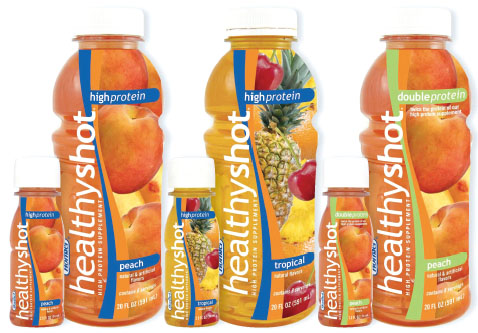 A UNIQUE 2.5oz PET bottle has been used for the first time by Hormel Health Labs for the launch of its new high-protein healthcare beverage. Dubbed "healthy shot," the high-powered, fruit-flavoured drink packs a full 12g of protein into those 2.5oz, and no less than 24g into its double-protein 2.5 formulation. To come up with the industry's smallest hot fill PET container, Amcor adapted its proprietary hot fill technology, used primarily for large containers, to create a relatively simple cylindrically-shaped bottle to meet the needs of the specialty healthcare beverage market. "Perhaps the most difficult part was getting heat set properties into a bottle that size," explained Kirk Maki, Amcor project engineer. "Vacuum control in hot filling and cooling is the other critical issue, which also required considerable manipulation." The entire package is 100 per cent recyclable and although the 2.5 ounce bottle is a relatively simple cylindrical shape, adapting technology used in larger containers was not a straightforward reduction process. Every size container and each design nuance impacts PET performance and presents new challenges.
A UNIQUE 2.5oz PET bottle has been used for the first time by Hormel Health Labs for the launch of its new high-protein healthcare beverage. Dubbed "healthy shot," the high-powered, fruit-flavoured drink packs a full 12g of protein into those 2.5oz, and no less than 24g into its double-protein 2.5 formulation. To come up with the industry's smallest hot fill PET container, Amcor adapted its proprietary hot fill technology, used primarily for large containers, to create a relatively simple cylindrically-shaped bottle to meet the needs of the specialty healthcare beverage market. "Perhaps the most difficult part was getting heat set properties into a bottle that size," explained Kirk Maki, Amcor project engineer. "Vacuum control in hot filling and cooling is the other critical issue, which also required considerable manipulation." The entire package is 100 per cent recyclable and although the 2.5 ounce bottle is a relatively simple cylindrical shape, adapting technology used in larger containers was not a straightforward reduction process. Every size container and each design nuance impacts PET performance and presents new challenges. Controlling the process
Maki said his team had to take a step back and determine how they were going to get the process control we needed on a much smaller container. In theory, 2 over 1 equals 10 over 5, but in practice it is very different. "First, we had to modify our equipment and add specialty machine controls. We had to downsize and modify the tooling to create a scaled down version of how we would normally process the container in order to drive heat set properties to a level high enough to prevent deformation under the heat. We accomplished what we set out to do. The heat set testing has come back at levels equal to or better than some of our other larger heat set containers," he said. Mr Maki acknowledged there were challenges with the overall bottle design relating to vacuum control. Testing and calculations based on container diameter were run up-front to ensure that specialty panelling wouldn't be needed. The panelling was fine when initial hot filling and cooling trials were run, but "the panel rib design had issues. Nothing critical, but we felt it just wasn't quite right," Maki said. So the team modified the rib portion of the design. In the process, they developed a superbly smooth area of labelling. "If you make a container that looks good with a wrap label, it will look great in a shrink label," he pointed out.Breaking the mould, literally
Mr Maki said the mini bottle's finish area added to the complexity of this project. Whereas the standard finish recalls an earlier PET era, it is not the kind of heat set finish one typically finds on a store shelf today. "When you have a relatively large 28mm opening on a 2.5oz container, compared to a 43mm opening on top of 500 ml bottle, you can't simply transfer technology," he said. "Although it is not as light in weight as some newer designs, it has a versatile finish. What allowed us to use it here is the fact that the bottle is small, so there's relatively little heat capacity." The closure itself is a standard design, borrowed from beverage packaging for this healthcare application. Compared with other bottles on the market today, which have smaller 20mm finish, the larger 28mm finish on this bottle makes it easier for patients to drink from. Because this hot fill bottle is so small compared to others on the market, it takes custom equipment to fill. Not many types of filler are currently set up to do it because there hasn't been a demand for hot fill in bottles this size. "We know it's a little difficult to maintain the heat when filling small containers whilst also maintaining throughput," said ChriAir Zoom Pegasus EM
 iConnectHub
iConnectHub
 Login/Register
Login/Register Supplier Login
Supplier Login


























